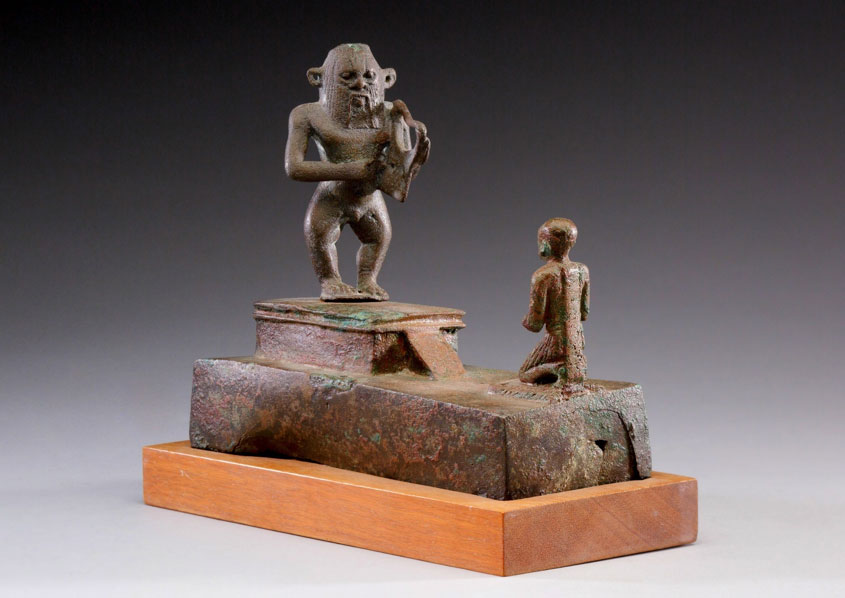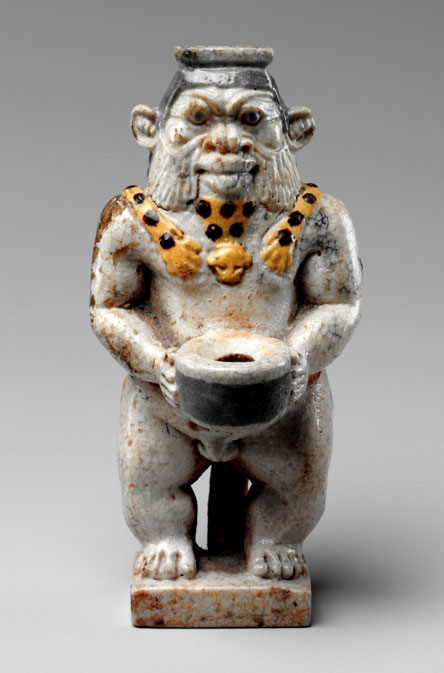
Bes, The Protector Deity: Exuberant Harbinger of Health, Happiness and Vitality – Part II
Few gods achieved the fame that the lion-dwarf Bes managed to garner. He was not only a popular god among the elite in ancient Egypt, but in time was worshipped by people of every strata of society. His unique appeal probably lay in the fact that he was a jovial deity who not only cared for, but was accessible to, the poorest of the poor. As a being who combated evil, along with his counterpart Beset, he proved to be an inalienable part of the lives of the devoted, across cultures and geographies.

Bes was worshipped and invoked by ordinary Egyptians as a protector. His usual depiction, as a grotesque dwarf with a lion's ears and mane, was thought to deter the approach of the malevolent forces believed to cause illness. His image here appears in a bronze statuette made for the unnamed man shown worshipping the god. The harp held by Bes may reflect his power to calm angry spirits. Bronze or copper alloy. Late Period, Dynasty 26–29. Metropolitan Museum of Art, New York.
Sublime Wands and Worship
Even though Bes was originally regarded as a deity who safe-guarded the pharaoh, with the passage of time he came to be increasingly revered by commoners too – so much so that he regularly made an appearance on domestic items such as chairs, headrests, beds, mirrors and ointment jars. He was even painted on the walls of houses. And, in keeping with his ferocious nature, images of Bes were represented on weapons too. Tutankhamun’s tomb also yielded a fair amount of Bes-related objects. But perhaps the most important occurrence of portrayals of Bes were on the ubiquitous magic (apotropaic) wands and amulets which were commonly employed by Egyptian priests and magicians as part of their rituals in casting spells to combat or discourage forces of evil.

Made of faience, this squat human form with leonine features is commonly identified as the god Bes, but several other minor Egyptian gods were also represented by this image. These were protective deities, so they appear frequently as apotropaic figures in the decoration of furniture and personal belongings. Here, the god stands holding the cap of a kohl container. 27th Dynasty, Late Period. Metropolitan Museum of Art, New York.
Apotropaic means something that turns away evil, particularly evil spirits. The ivory from which most of the wands are made placed the formidable power of the hippopotamus in the hand of the magician. The earliest known wands go back to around 2800 BC. Geraldine Pinch provides further insights: “Around 2100 BC, a new type of wand came in to use with elaborate incised or carved decoration on one or both sides. An array of creatures is shown and there can be brief inscriptions. The creatures include lions, panthers, cats, baboons, bulls, turtles, snakes, scarab-beetles, frogs and crocodiles. There are also imaginary monsters such as the Seth animal, the griffin, a panther-like beast with an elongated neck, a double sphinx, the composite form of Taweret, and a naked bandy-legged dwarf with the ears and mane of a lion. This lion demon was later known by the specific name of Bes, while his female counterpart was Beset.”
During the period in which these wands were produced, demons of the kind Geraldine Pinch mentions appear to have unanimously been named ‘Aha’, fighter. Consequently, this name could be applied to a host of beings who were symbolized on the wands. While some of these savage fighters are shown holding knives and torches; others grip or stab serpents and other vile creatures.
Headrests decorated with Bes and Taweret figures of this nature were popular in the ancient village of the artisans (modern Deir el-Medina) who worked on the sepulchers of the pharaohs in the Valley of the Kings.




